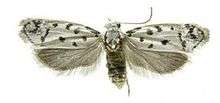Ethmia helenmillerae
Ethmia helenmillerae is a moth in the family Depressariidae. It is found in Costa Rica, where it has been recorded from the Pacific slope of the Cordillera de Guanacaste at altitudes ranging from 0 to 579 meters (0 to 1,900 ft). The habitat consists of dry forests.
| Ethmia helenmillerae | |
|---|---|
 | |
| Scientific classification | |
| Kingdom: | |
| Phylum: | |
| Class: | |
| Order: | |
| Family: | |
| Genus: | |
| Species: | E. helenmillerae |
| Binomial name | |
| Ethmia helenmillerae Phillips, 2014 | |
The length of the forewings is 6.3–6.8 mm (0.25–0.27 in) for males and 6.5–7.5 mm (0.26–0.30 in) for females. The ground color of the forewings is white with six defined dots distributed on two-thirds from the base. There is a line at the terminal area from almost the center of the wing to the tornum. The hindwing ground color is dark brown.
Etymology
The species is named in honor of Helen Miller, an early major donor for Area de Conservación Guanacaste rain forest purchase.[1]
gollark: I'm a self-employed beekeeper/[REDACTED].
gollark: (a mobile phone, as you said)
gollark: <@319753218592866315> I roll for having a phone at home, d6.
gollark: Wait, hmm.
gollark: How much do *I* have?
References
- Phillips-Rodríguez, E; Powell, J; Hallwachs, W; Janzen, D (2014). "A synopsis of the genus Ethmia Hübner in Costa Rica: biology, distribution, and description of 22 new species (Lepidoptera, Gelechioidea, Depressariidae, Ethmiinae), with emphasis on the 42 species known from Área de Conservación Guanacaste". ZooKeys (461): 1–86. doi:10.3897/zookeys.461.8377.
This article is issued from Wikipedia. The text is licensed under Creative Commons - Attribution - Sharealike. Additional terms may apply for the media files.